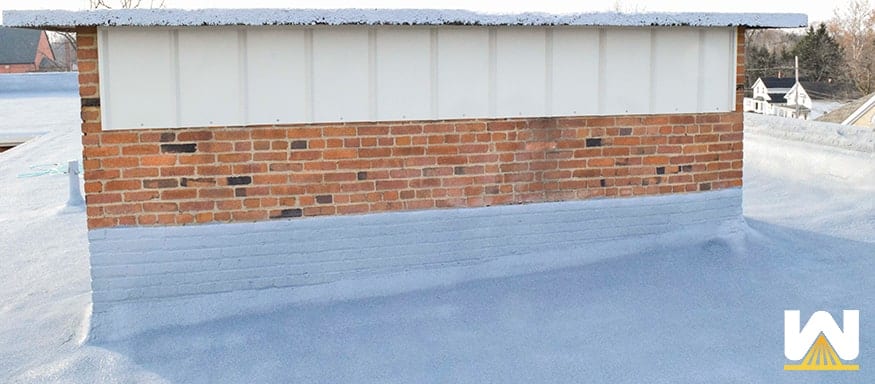Say you live in Canada where it gets to -40 degrees Fahrenheit at some points in the winter, and you’re searching for a roofing solution for your commercial building.
You come across an article about spray polyurethane foam, learn that spray foam roofing can provide the greatest R value of any roofing system per inch, and now, due to the cold winters and high energy bills, R value is a top priority.
Your main concern might be, “Will this new spray foam roof be able to withstand these harsh winters?”
Concerns you might have could be:
- Are there issues with installing spray foam in cold temperature?
- Will heavy snow damage the spray foam roof?
- How does the foam roof perform in cold temperature?
- Does the foam roof last as long in cold temperature vs warm temperature?
- What happens to the spray foam roof when it freezes?
Let’s begin…
Spray Polyurethane Foam Roofing Concerns in Colder Climates
Are there issues with installing spray foam in cold temperature?
For spray foam to be laid down properly on a commercial building, the temperature needs to be 50 degrees Fahrenheit and rising on the surface substrate. This is different than ambient air temperature.
The roofing surface also needs to be dry.
If either of these two factors aren’t met, the foam won’t develop the proper physical properties.
The time frame when these two factors are met is usually diminished compared to warmer areas. For example, in Florida, it could be 50 degrees on the roof almost every day of the year. In Canada, late May until early September might be the only times of the year in which it’s appropriate to spray foam on your roof.
Will heavy snow damage the spray foam roof?
Approximately 1 inch of snowfall on your roof weighs approximately one pound per square foot.
With spray polyurethane foam also weighing about one pound per square foot, the two pounds per square foot is not much stress on your roof.
To compare, a 3-ply Built-up roof can weigh 6 pounds per square foot without snow.
I asked Brian Chavalia (30+ year spray foam roofing legend at West Roofing Systems), and he claimed to never have an issue with snow weight on a foam roof. While most of Brian’s work has come in Ohio, he has sprayed foam himself in Canada, and has worked with numerous Canadian roofing contractors.
Clearly spray foam has no issues being sprayed in the coldest of climates.
How does the foam roof perform in cold temperatures?
Spray polyurethane foam for a roofing application performs just as good in cold climates as it does in warmer climates.
The goal of a spray foam roof is to provide a seamless, monolithic layer that prevents roof leaks and keeps heat/coolness from exiting the building.
With spray foam having the highest R value per inch of any roofing system, one can argue that spray foam performs best in extreme climates.
In the extreme cold, the spray foam roof will keep your buildings heat inside the building, therefore reducing the amount of wear and tear on your HVAC units, and saving you money in energy costs.
Does the spray foam roof last as long in cold temperature vs warm temperature?
Since 1979, West Roofing Systems has been spraying foam on roofs in many different climates, including the coldest of winters in Minnesota, all the way to the warmest of summers in Iraq.
According to manufacturer warranties, the spray foam roof is meant to last 10, 15 and 20 years before a simple recoat is necessary.
After the initial warranty, the silicone coating on top of the foam roof system will wear down due to weather, foot traffic, etc. What once was a 20-mil coating on year 1, might go down to 7-8 mils after year 10.
With routine maintenance scheduled and a recoat after the initial warranty expiration, a spray foam roof can be the last roof you’ll ever have to install.
What happens to the spray foam roof when it freezes?
In our years of business, the freezing of the spray foam roof has never been an issue. We have no reports of cracking, breaking or excessive wear on the roof due to freezing conditions.
Other roofing systems, such as a rubber roof, may have this issue. If there’s any uplift in the seams, water can get inside, freeze, and once it’s thawed, that seam uplift expands and can create an even larger opportunity for water to enter the building.
With spray foam roofs being closed-cell and one monolithic layer across the entire roof, seams freezing, thawing and expanding is not an issue.
Closing touches on spray foam roofing in colder climates
Today we’ve gone through possible scenarios where spray foam roofing can endure colder climates. The main negative we can take away from all this, is the limited window of opportunity to get to the optimal 50 degrees Fahrenheit temperature range to install the roof.
How can you get past the limited window?
Get in touch with a roofing contractor as early as possible. Roofing contractors schedule jobs several months in advance, so if you can beat the rush of companies reaching out for roofing help at peak times (usually beginning in February/March), you can cement your project during the summer months.
If you’d like to learn more about pricing, installation, and common problems with a spray polyurethane roof, please click the image below:


